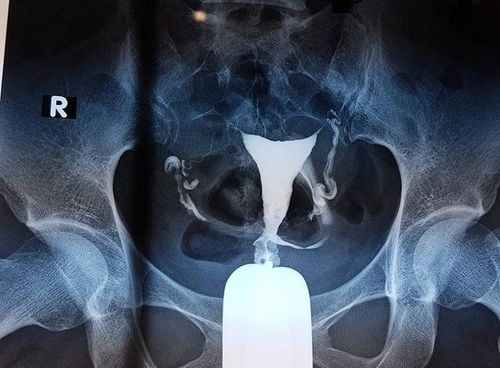This is an automatically translated article.
Endometriosis is 1 in 10 women diagnosed with endometriosis. However, it takes about 3 to 10 years to detect the disease, because the symptoms of the disease are not obvious in the early stages of the disease. Endometriosis can cause health risks for women, including reproductive health, and can even cause infertility.1. Endometriosis in women
Endometriosis occurs when tissues similar to the lining of the uterus grow on the outside of the uterus or possibly in the uterus. Ectopic sites are usually in other organs inside the pelvis or abdominal cavity. Endometrial cysts can swell or bleed, a process similar to how the lining of the uterus works every month, causing bleeding inside the pelvis and abdominal pain on arrival. menstrual cycle .As endometrioma continues to grow, it can cause a number of problems such as:
Fallopian tubes are blocked by the tumor covering or damaging the ovaries, causing blood to become trapped in the ovaries. eggs and are at risk of cyst formation. Inflammation, swelling, or abdominal pain often occurs during the menstrual cycle Scar tissue and adhesions - tissues capable of connecting with other organs are formed. This scar tissue can cause pelvic pain and make it difficult to conceive. Or bowel and bladder problems. Endometriosis has three main types and is determined based on the site of onset of the disease:
Location of damage to the outer peritoneum. This is considered the most common type of endometriosis along with the appearance of lesions on the peritoneum - the thin membrane that covers the inside of the abdomen or internal organs and the abdominal cavity. Endometriomas with ovarian lesions are dark, fluid-filled cysts that form deep in a patient's ovaries. These fluids can damage healthy tissue in surrounding organs. Deep-infiltrating endometrium grows under the peritoneum and damages organs near the uterus such as the bowel or bladder, and it occurs in about 1 to 5% of women.
2. Causes of endometriosis in women
Because the cause of endometriosis is not clear, most cases are detected at a late stage. Some of the identifiable causes of endometriosis include:Retrograde menstrual flow is considered the primary cause of endometriosis, where menstrual tissue flows backward through the ducts. eggs are simultaneously deposited on the pelvic organs. After that, the day condition will multiply and develop. Genetic factors with family cases of endometriosis and the possibility of genetic inheritance. The immune system is faulty and will not recognize and destroy endometrial tissue and will grow outside of the uterus Good endocrine with high estrogen hormone changes in the body will cause pregnancy endometriosis. Certain abdominal surgical procedures such as cesarean section or hysterectomy can allow endometrial tissue to form and grow. At-risk cases for endometriosis are most common in women with menstrual cycles and are more common in women between the ages of 30 and 40. Some women may have a higher risk of endometriosis, such as women who have never had children, their menstrual periods last longer than 7 days, or their menstrual cycles are shorter than 27 days, and their families have money. a history of endometriosis, or a medical condition that prevents the normal flow of menstrual blood out of the body during the menstrual cycle.
3. Signs and symptoms of endometriosis in women
Symptoms of endometriosis will vary from person to person. Every woman will have symptoms that can range from mild to severe. Symptoms of endometriosis often include:Pain is considered a common symptom of endometriosis that any woman can experience. Women with endometriosis face pain: Dysmenorrhea with pain that can get worse over time. Chronic pain in the pelvis or lower back. During and after sex causes a woman pain. The pain is described as a deep pain, and is different from pain on the outside of the vagina when receiving the penis. Pain during defecation or urination affects the nerves that connect to the groin, hips and legs, making it difficult for a woman to walk. Bleeding that occurs in the middle of the menstrual cycle Stomach or digestive problems including diarrhea, constipation, bloating, nausea or vomiting occur during menstruation. However, there are many cases of women with endometriosis without any signs or symptoms of endometriosis. Therefore, women should go to gynecological health check-ups periodically so that they can screen and detect diseases early so that they can have timely support plans.
4. Complications of endometriosis in women
About 40% of women who have difficulty getting pregnant will be diagnosed with endometriosis. The researchers believe that the inflammation caused by endometriosis in women affects the development and quality of the ovum, making it harder for sperm to move when searching for an egg. Moreover, adhesions can block the fallopian tubes, thereby hindering the process of sperm finding an egg and making it difficult to conceive.Besides, the pain caused by endometriosis also affects a woman's quality of life. Some women may experience pain to the point of depression, anxiety, etc., requiring mental health therapy.
In addition, endometriosis can also increase the risk of ovarian cancer, breast cancer and adenocarcinoma.
5. Some measures to prevent endometriosis
Endometriosis can happen to any woman. However, there are some things you can do to help reduce the risk of developing the disease by reducing the levels of the hormone estrogen in your body, such as:Consult your doctor about birth control methods hormonal changes such as using the pill or patch or the hormonal IUD. Regularly move and exercise for a minimum of 4 hours/week to help keep the percentage of body fat low and within the allowable limit. At the same time, applying exercises to reduce fat helps reduce estrogen levels in the body. Avoid the use of alcohol and beer. Because, studies have shown that alcohol or beer has the ability to increase estrogen hormone levels. Limit the use of beverages containing caffeine compounds. Because more than one caffeinated beverage per day is also a risk factor for increased estrogen levels. In order to help customers detect and treat gynecological diseases early, Vinmec International Hospital has a basic gynecological examination and screening package, helping customers detect early infectious diseases and help treat easy, inexpensive. Screening detects gynecological cancer (cervical cancer) early even when there are no symptoms.
Basic gynecological examination and screening package for female customers, has no age limit and may have the following symptoms:
Abnormal vaginal bleeding Having menstrual problems: irregular menstrual cycle, irregular menstrual cycle Irregular vaginal discharge (smell, different color) Vaginal pain and itching Female clients have several risk factors such as poor personal hygiene, Unsafe sex, abortion,... Female customers have other symptoms such as: Abnormal vaginal discharge, itching, pain in the private area, abnormal vaginal bleeding.
Please dial HOTLINE for more information or register for an appointment HERE. Download MyVinmec app to make appointments faster and to manage your bookings easily.













